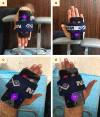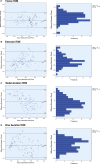Reliability and concurrent validity of a new iPhone® goniometric application for measuring active wrist range of motion: a cross-sectional study in asymptomatic subjects
- PMID: 27910103
- PMCID: PMC5314391
- DOI: 10.1111/joa.12568
Reliability and concurrent validity of a new iPhone® goniometric application for measuring active wrist range of motion: a cross-sectional study in asymptomatic subjects
Abstract
Measurement of wrist range of motion (ROM) is often considered to be an essential component of wrist physical examination. The measurement can be carried out through various instruments such as goniometers and inclinometers. Recent smartphones have been equipped with accelerometers and magnetometers, which, through specific software applications (apps) can be used for goniometric functions. This study, for the first time, aimed to evaluate the reliability and concurrent validity of a new smartphone goniometric app (Goniometer Pro©) for measuring active wrist ROM. In all, 120 wrists of 70 asymptomatic adults (38 men and 32 women; aged 18-40 years) were assessed in a physiotherapy clinic located at the School of Rehabilitation Sciences, Iran University of Medical Science and Health Services, Tehran, Iran. Following the recruitment process, active wrist ROM was measured using a universal goniometer and iPhone® 5 app. Two blinded examiners each utilized the universal goniometer and iPhone® to measure active wrist ROM using a volar/dorsal alignment technique in the following sequences: flexion, extension, radial deviation, and ulnar deviation. The second (2 h later) and third (48 h later) sessions were carried out in the same manner as the first session. All the measurements were conducted three times and the mean value of three repetitions for each measurement was used for analysis. Intraclass correlation coefficient (ICC) models (3, k) and (2, k) were used to determine the intra-rater and inter-rater reliability, respectively. The Pearson correlation coefficients were used to establish concurrent validity of the iPhone® app. Good to excellent intra-rater and inter-rater reliability was demonstrated for the goniometer with ICC values of ≥ 0.82 and ≥ 0.73 and the iPhone® app with ICC values of ≥ 0.83 and ≥ 0.79, respectively. Minimum detectable change at the 95% confidence level (MDC95 ) was computed as 1.96 × standard error of measurement × √2. The MDC95 ranged from 1.66° to 5.35° for the intra-rater analysis and from 1.97° to 6.15° for the inter-rater analysis. The concurrent validity between the two instruments was high, with r values of ≥ 0.80. From the results of this cross-sectional study, it can be concluded that the iPhone® app possesses good to excellent intra-rater and inter-rater reliability and concurrent validity. It seems that this app can be used for the measurement of wrist ROM. However, further research is needed to evaluate symptomatic subjects using this app.
Keywords: arthrometry, articular; range of motion, articular; smartphone; wrist joint.
© 2016 Anatomical Society.
Figures







References
-
- Adams L, Greene L, Topoozian E (1992) Range of motion. Clin Assess Recommend 2, 55–70.
-
- Bain GI, Clifton T, Costi JJ, et al. (2016) Biomechanics of the rheumatoid wrist deformity In: Clinical Management of the Rheumatoid Hand, Wrist and Elbow. (ed. Chung KC.), pp. 75–86, Cham: Springer.
-
- Bland JM, Altman DG (1999) Measuring agreement in method comparison studies. Stat Methods Med Res 8, 135–160. - PubMed
Publication types
MeSH terms
LinkOut - more resources
Full Text Sources
Other Literature Sources
Medical

